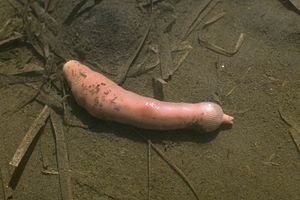Urechis caupo
| Urechis caupo | ||||||||||||
|---|---|---|---|---|---|---|---|---|---|---|---|---|

Urechis caupo |
||||||||||||
| Systematics | ||||||||||||
|
||||||||||||
| Scientific name | ||||||||||||
| Urechis caupo | ||||||||||||
| Fisher & MacGinitie , 1928 |
Urechis caupo is the name of a very large species of hedgehog worms (Echiura) from the Urechidae family that burrows in the sand and is distributed in the Pacific Ocean on thewest coastof North America .
features
The cigar-shaped to sausage-shaped, pink body of Urechis caupo has wrinkled skin and is usually around 20 cm, but occasionally up to 50 cm long. At the front there are two sharply pointed hooks on the belly side, around the anus at the end of the trunk a conspicuous ring of 10 to 11 bristles. At the front end near the mouth there is a spoon-shaped, short proboscis .
Urechis caupo has 3 pairs of nephridia . The lining of the oral cavity and the pharynx forms continuous, distinctive longitudinal folds that do not form a zigzag, but rather abruptly merge into finer, wrinkled transverse folds at the beginning of the esophagus. The large hindgut has a thin translucent wall that is sharply set off from the thicker wall of the midgut. The cloaca is about twice as large as that of Urechis chilensis .
Distribution and occurrence
Urechis caupo is distributed in the Pacific Ocean on the west coast of the United States from southern Oregon through California to Tijuana in Mexico . It lives in the lower intertidal zone and is buried in the sand below.
Way of life
Urechis caupo digs a U-shaped living cave, the entrance and exit of which are about 40 to 100 cm apart and which is about 10 to 45 cm deep. Through peristaltic movements of the body, it creates a flow of water to supply oxygen and fine food particles, which are filtered out of the water using a network of mucus. Particles from about 1 µm in size stick to it. If there are enough particles on the slime web, it will be swallowed.
The cave is inhabited by numerous commensals , including the crabs Pinnixa franciscana and Scleroplax granulata , the bristle worm Hesperonoe adventor , the clam Cryptomya californica and the fish Clevelandia ios .
Life cycle
In Urechis caupo , males and females are the same size and come together in larger groups for mating in early summer. The white sperm and the pink-colored eggs are formed in the Coelom fluid and released to the outside via the nephridia, so that fertilization takes place in the open sea water. The swimming trochophora larvae live pelagic for about 60 days before they sink and metamorphose into worms living on the ground .
Predators
Important predators are the flatfish Paralichthys californicus and Hypsopsetta guttulata , leopard sharks , which can suck the worms out of their burrows , and sea otters . A common endoparasite in the intestine is the single cell Echiurocystis bullis . In the US, worms are generally not eaten by humans, but they are used as fishing bait.
literature
- WK Fisher (1946): Echiuroid worms of the North Pacific Ocean. Proceedings of the US National Museum 96, pp. 215-292
- WK Fisher, GE MacGinitie (1928): The natural history of an echiuroid worm (Urechis). Ann. Mag. Natural History (10) 1, pp. 204-213.